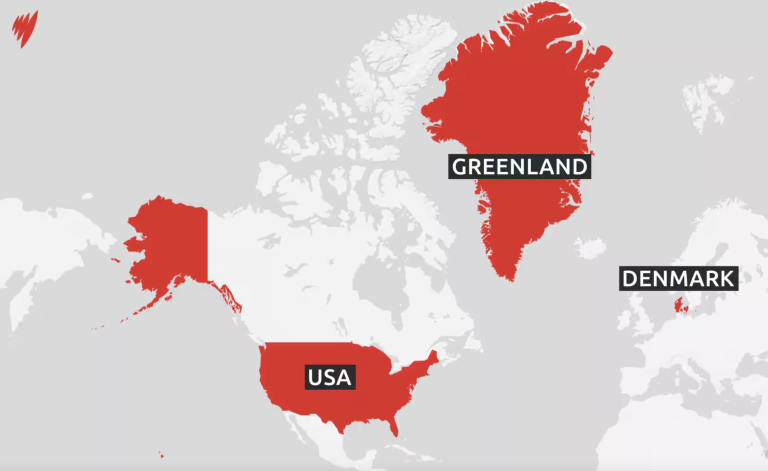
Trump’s Greenland Irony: U.S. Can Deploy Troops Now
Washington, D.C. — In a twist of geopolitical irony, President Donald Trump’s recent remarks about bolstering Greenland’s defenses have sparked a wave of concern among analysts and policymakers. Trump, known for his off-the-cuff statements, suggested that the United States should take a more active role in securing the strategically vital Arctic territory.
What he may not realize—or perhaps conveniently overlooked—is that the U.S. already possesses the legal authority to deploy additional troops to Greenland immediately, thanks to a decades-old agreement with Denmark.
The 1951 Defense Treaty between the United States and Denmark explicitly permits the U.S. to establish new “defense areas” on Greenlandic soil, a provision that raises pressing questions about sovereignty, military escalation, and the fragile balance of power in the Arctic.

The treaty, signed in the early years of the Cold War, was designed to counter Soviet influence in the North Atlantic. It allows the U.S. to create and operate defense installations deemed “necessary for the development of the defense of Greenland and the rest of the North Atlantic Treaty area,” particularly when Denmark lacks the resources to do so independently.
At the time, Greenland—still a Danish territory—was seen as a critical outpost for monitoring Soviet activities. Today, however, the agreement takes on new significance as global powers, including Russia and China, vie for influence in the rapidly warming Arctic, where melting ice is unlocking access to valuable resources and shipping routes.
Trump’s comments, made during a recent interview, hinted at a desire to “protect” Greenland, an idea he famously floated in 2019 when he suggested purchasing the island outright. “Greenland’s got a lot of potential, folks—strategically, militarily. We should be there,” he said, doubling down on his vision of American dominance in the region.
Yet the irony is stark: the U.S. doesn’t need to negotiate, buy, or cajole its way into Greenland. The 1951 agreement already provides a legal framework for expanding its military footprint—an option that successive administrations have exercised cautiously, mindful of Denmark’s sensitivities and Greenland’s push for greater autonomy.
Currently, the U.S. operates Thule Air Base in northwestern Greenland, a key hub for missile defense and satellite tracking. Established under the 1951 treaty, Thule remains a linchpin in NATO’s northern defenses. But the agreement’s language is broad, allowing for new bases or troop deployments if deemed necessary. \
With Russia modernizing its Arctic military capabilities and China eyeing Greenland’s rare earth minerals, some U.S. hawks argue that now is the time to act. “The treaty gives us a blank check,” said a senior Pentagon official, speaking anonymously. “We could reinforce Greenland tomorrow if we wanted to.”
That possibility, however, is precisely what worries experts. Greenland’s 56,000 residents, many of whom aspire to independence from Denmark, view foreign military presence with suspicion. A sudden influx of U.S. troops could inflame tensions with the local population and strain relations with Copenhagen, which retains authority over Greenland’s foreign and defense policy.
“The U.S. has to tread carefully,” said Dr. Anna Sørensen, an Arctic security scholar at the University of Copenhagen. “Escalating militarization risks alienating both Greenlanders and our Danish allies.”
Moreover, any move to expand U.S. forces could provoke Russia, which has already accused NATO of encroaching on its Arctic sphere of influence. Moscow’s recent deployment of hypersonic missiles in the region underscores the stakes. “This is a powder keg,” warned retired Admiral James Foggo, a former NATO commander. “Trump’s rhetoric might sound tough, but it could drag us into a confrontation we’re not prepared for.”
For now, the Biden administration has downplayed Trump’s remarks, emphasizing dialogue with Denmark and NATO partners. Yet the 1951 treaty looms as a quiet wildcard—one that could reshape the Arctic’s future with little notice. As climate change accelerates and great-power competition intensifies, Greenland’s strategic value will only grow. The question is whether the U.S. will use its existing authority to act, or if Trump’s words will remain just that: words.
The irony isn’t lost on observers. Trump, who once mused about buying Greenland, already holds the keys to its defense. But unlocking that door could come at a cost no one is ready to pay.
#GreenlandDefense #TrumpArctic #USDenmarkTreaty #ArcticSecurity
Tags: Greenland, Trump, U.S. military, Denmark, 1951 treaty, Arctic, NATO, Russia, geopolitics
75-Word Summary
Yoast SEO Focus Key Phrase
U.S.-Denmark 1951 Greenland treaty
Yoast Meta Description
Explore how the 1951 U.S.-Denmark treaty lets America deploy troops to Greenland, spotlighted by Trump’s ironic defense remarks. Learn the risks and stakes.